An Improved Time-Frequency Analysis Method for Hydrocarbon Detection Based on EWT and SET
Abstract
:1. Introduction
2. Theory
2.1. Empirical Wavelet Transform (EWT)
- (1)
- Apply the FFT to the analyzed signal to obtain the frequency spectrum .
- (2)
- Estimate the relative optimal number N of modes, identify the largest N−1 maxima in , and sort them in decreasing order. Calculate the center between two consecutive maxima as the boundaries , thus obtain N−1 extra boundaries except 0 and .
- (3)
- According to the same method for the classic wavelet transform, the detail coefficients is defined by the inner products with the empirical wavelets. The approximation coefficient is denoted by the convention , which is given by the inner products with scaling function. The reconstruction can be given by:where represents the convolution operation.
- (4)
- According to the above formalism, the empirical mode can be expressed as:
2.2. Synchroextracting Transform (SET)
2.3. EWT-SET as a Hydrocarbon Detection Tool
- (1)
- Decompose the target seismic signal into a series of IMFs using EWT, which can be expressed as gradual AM-FM signals.
- (2)
- Apply the SET to the IMFs to remove the most-smeared time-frequency energy and to obtain the energy-concentrated time-frequency spectrum.
- (3)
- Choose characteristic frequencies based on the attenuation comparison of several seismic traces.
- (4)
- Extract common frequency data based on the time-frequency spectrum obtained from EWT-SET, which can be employed to reveal the abnormal attenuation associated with hydrocarbons.
3. Comparative Analysis Between SET, EWT-SET, and EWT-HT
4. Hydrocarbon Detection Using EWT-SET
4.1. Model Test
4.2. Field Data
4.2.1. Characteristic Frequency Selection
4.2.2. Hydrocarbon Detection
5. Conclusions
Acknowledgments
Author Contributions
Conflicts of Interest
References
- Zou, C.; Yang, Z.; Dai, J.; Dong, D.; Zhang, B.; Wang, Y.; Deng, S.; Huang, J.; Liu, K.; Yang, C.; et al. The characteristics and significance of conventional and unconventional Sinian–Silurian gas systems in the Sichuan Basin, central China. Mar. Pet. Geol. 2015, 64, 386–402. [Google Scholar] [CrossRef]
- Holditch, S.A. Tight gas sands. J. Pet. Technol. 2006, 58, 86–93. [Google Scholar] [CrossRef]
- Cander, H. What is unconventional resources. In Proceedings of the AAPG Annual Convention and Exhibition, Long Beach, CA, USA, 22–25 April 2012; pp. 1–3. [Google Scholar]
- Dewhurst, D.N.; Jones, R.M.; Raven, M.D. Microstructural and petrophysical characterization of Muderong Shale: Application to top seal risking. Pet. Geosci. 2002, 8, 371–383. [Google Scholar] [CrossRef]
- Bourdet, J.; Pironon, J.; Levresse, G.; Tritlla, J. Petroleum accumulation and leakage in a deeply buried carbonate reservoir, Níspero field (Mexico). Mar. Pet. Geol. 2010, 27, 126–142. [Google Scholar] [CrossRef]
- Partyka, G.; Gridley, J.; Lopez, J. Interpretational applications of spectral decomposition in reservoir characterization. Lead. Edge 1999, 18, 353–360. [Google Scholar] [CrossRef]
- Liu, J.L.; Marfurt, K.J. Instantaneous spectral attributes to detect channels. Geophysics 2007, 72, P23–P31. [Google Scholar] [CrossRef]
- Huang, Z.; Zhang, J.; Zhao, T.; Sun, Y. Synchrosqueezing S-Transform and Its Application in Seismic Spectral Decomposition. IEEE Trans. Geosci. Remote Sens. 2016, 54, 817–825. [Google Scholar] [CrossRef]
- Wu, X.Y.; Liu, T.Y. Seismic spectral decomposition and analysis based on Wigner–Ville distribution for sandstone reservoir characterization in West Sichuan depression. J. Geophys. Eng. 2010, 7, 126–134. [Google Scholar] [CrossRef]
- Castagna, J.P.; Sun, S.J.; Siegfried, R.W. Instantaneous spectral analysis: Detection of low-frequency shadows associated with hydrocarbons. Lead. Edge 2003, 22, 120–127. [Google Scholar] [CrossRef]
- Liu, C.C.; Chen, B.S.; Han, M.; Han, L.G.; Shang, S. Reassigned wavelet spectral decomposition and its application in hydrocarbon detection. In Proceedings of the SEG Technical Program Expanded Abstracts 2013, Houston, TX, USA, 22–27 September 2013; pp. 2611–2615. [Google Scholar]
- Liu, W.; Cao, S.; Wang, Z.; Kong, X.; Chen, Y. Spectral Decomposition for Hydrocarbon Detection Based on VMD and Teager–Kaiser Energy. IEEE Geosci. Remote Sens. Lett. 2017, 14, 539–543. [Google Scholar] [CrossRef]
- Sinha, S.; Routh, P.S.; Anno, P.D.; Castagna, J.P. Spectral decomposition of seismic data with continuous-wavelet transform. Geophysics 2005, 70, 19–25. [Google Scholar] [CrossRef]
- De Matos, M.C. Characterization of thin beds through joint time-frequency analysis applied to a turbidite reservoir in Campos Basin, Brazil. In Proceedings of the SEG Technical Program Expanded Abstracts 2005, Houston, TX, USA, 6–11 November 2005; pp. 1429–1432. [Google Scholar]
- Li, D.; Castagna, J.; Goloshubin, G. Investigation of generalized S-transform analysis windows for time-frequency analysis of seismic reflection data. Geophysics 2016, 81, V235–V247. [Google Scholar] [CrossRef]
- Zhang, X.; Han, L.; Wang, Y.; Shan, G. Seismic spectral decomposition fast matching pursuit algorithm and its application. Geophys. Prospect. Pet. 2010, 49, 1–6. [Google Scholar]
- Tary, J.B.; Herrera, R.H. Spectral estimation—What is new? What is next? Rev. Geophys. 2014, 52, 723–749. [Google Scholar] [CrossRef]
- Huang, N.E.; Shen, Z.; Long, S.R.; Wu, M.C.; Shih, H.H.; Zheng, Q.; Yen, N.-C.; Tung, C.C.; Liu, H.H. The empirical mode decomposition and the Hilbert spectrum for nonlinear and non-stationary time series analysis. Proc. R. Soc. Lond. A 1998, 454, 903–995. [Google Scholar] [CrossRef]
- Tong, W.; Zhang, M.; Yu, Q.; Zhang, H. Comparing the applications of EMD and EEMD on time–frequency analysis of seismic signal. J. Appl. Geophys. 2012, 83, 29–34. [Google Scholar]
- Han, J.J.; van der Baan, M. Empirical mode decomposition for seismic time-frequency analysis. Geophysics 2013, 78, O9–O19. [Google Scholar] [CrossRef]
- Xue, Y.; Cao, J.; Tian, R.; Du, H.; Shu, Y. Application of the empirical mode decomposition and wavelet transform to seismic reflection frequency attenuation analysis. J. Pet. Sci. Eng. 2014, 122, 360–370. [Google Scholar] [CrossRef]
- Daubechies, I.; Lu, J.; Wu, H.-T. Synchrosqueezed wavelet transforms: An empirical mode decomposition-like tool. Appl. Comput. Harmon. Anal. 2011, 30, 243–261. [Google Scholar] [CrossRef]
- Chen, Y.; Liu, T.; Chen, X.; Li, J.; Wang, E. Time-frequency analysis of seismic data using synchrosqueezing wavelet transform. J. Seism. Explor. 2014, 23, 303–312. [Google Scholar]
- Herrera, R.H.; Han, J.; van der Baan, M. Applications of the synchrosqueezing transform in seismic time-frequency analysis. Geophysics 2014, 79, V55–V64. [Google Scholar] [CrossRef]
- Yu, G.; Yu, M.; Xu, C. Synchroextracting Transform. IEEE Trans. Ind. Electron. 2017, PP, 1. [Google Scholar] [CrossRef]
- Gilles, J. Empirical wavelet transform. IEEE Trans. Signal Process. 2013, 61, 3999–4010. [Google Scholar] [CrossRef]
- Kedadouche, M.; Thomas, M.; Tahan, A. A comparative study between Empirical Wavelet Transforms and Empirical Mode Decomposition Methods: Application to bearing defect diagnosis. Mech. Syst. Signal Process. 2016, 81, 88–107. [Google Scholar] [CrossRef]
- Müller, T.M.; Gurevich, B.; Lebedev, M. Seismic wave attenuation and dispersion resulting from wave-induced flow in porous rocks—A review. Geophysics 2010, 75, 75A147–75A164. [Google Scholar] [CrossRef]
- Tary, J.B.; van der Baan, M.; Herrera, R. Attenuation estimation using high resolution time–frequency transforms. Digit. Signal Process. 2016, 60, 46–55. [Google Scholar] [CrossRef]
- Yin, X.Y.; Zong, Z.Y.; Wu, G.C. Research on seismic fluid identification driven by rock physics. Sci. China Earth Sci. 2015, 58, 159–171. [Google Scholar] [CrossRef]
- Goloshubin, G.; Van Schuyver, C. Reservoir imaging using low frequencies of seismicreflections. Lead. Edge 2006, 25, 527–531. [Google Scholar] [CrossRef]
- Xiong, X.-J.; He, X.-L.; Pu, Y.; He, Z.-H.; Lin, K. High-precision frequency attenuation analysis and its application. Appl. Geophys. 2011, 8, 337–343. [Google Scholar] [CrossRef]
- Li, F.; Li, W.; Li., Y.; Zhang, Y.; Zheng, X. Hydrocarbon detection for cavern carbonate reservoir using low-and-high-frequency anomalies in spectral decomposition. In Proceedings of the SEG Technical Program Expanded Abstracts 2012, Las Vegas, NV, USA, 4–9 November 2012; pp. 1–5. [Google Scholar]
- Xue, Y.; Cao, J.; Tian, R. A comparative study on hydrocarbon detection using three EMD-based time–frequency analysis methods. J. Appl. Geophys. 2013, 89, 108–115. [Google Scholar] [CrossRef]
- Zou, C.; Zhu, R.; Liu, K.; Su, L.; Bai, B.; Zhang, X.; Yuan, X.; Wang, J. Tight gas sandstone reservoirs in China: Characteristics and recognition criteria. J. Pet. Sci. Eng. 2012, 88, 82–91. [Google Scholar] [CrossRef]
- Korneev, V.A.; Goloshubin, G.M. Seismic low-frequency effects in monitoring fluid-saturated reservoirs. Geophysics 2004, 69, 522–532. [Google Scholar] [CrossRef]
- Xue, Y.; Cao, J.; Tian, R. EMD and Teager–Kaiser energy applied to hydrocarbon detection in a carbonate reservoir. Geophys. J. Int. 2014, 197, 277–291. [Google Scholar] [CrossRef]
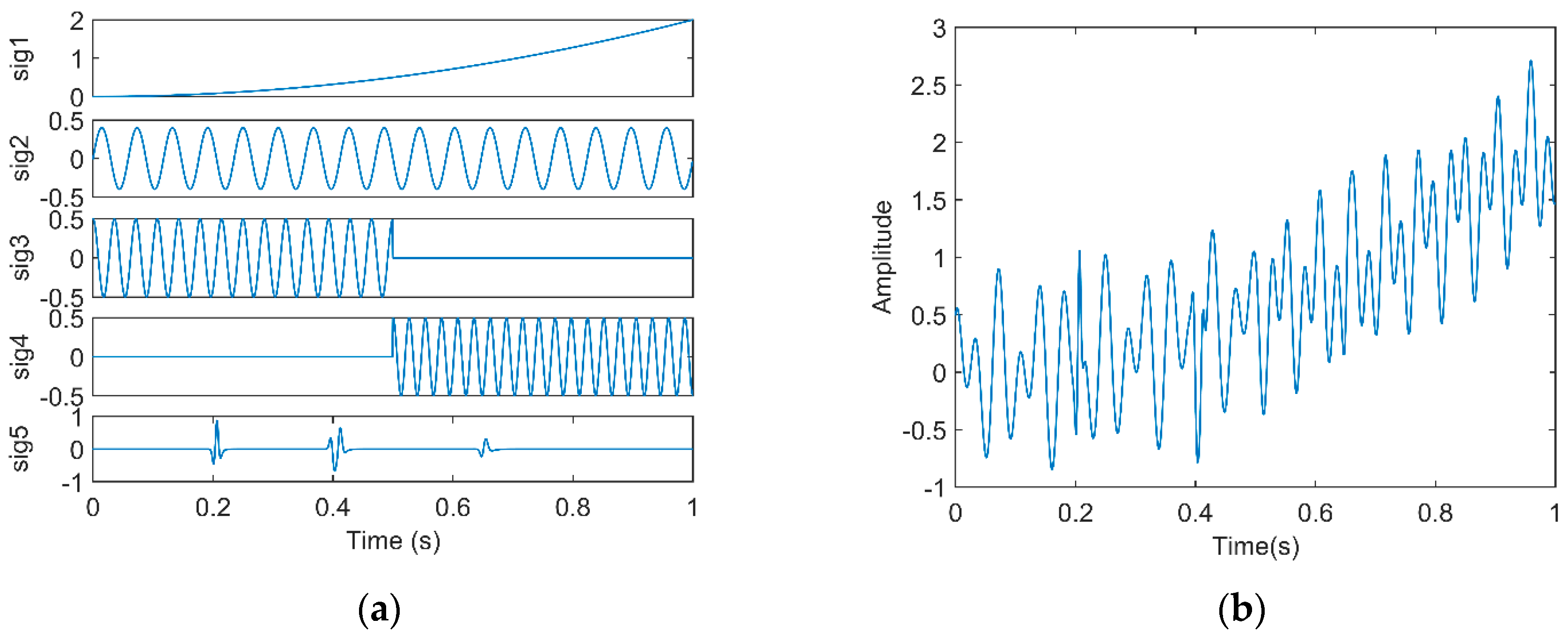
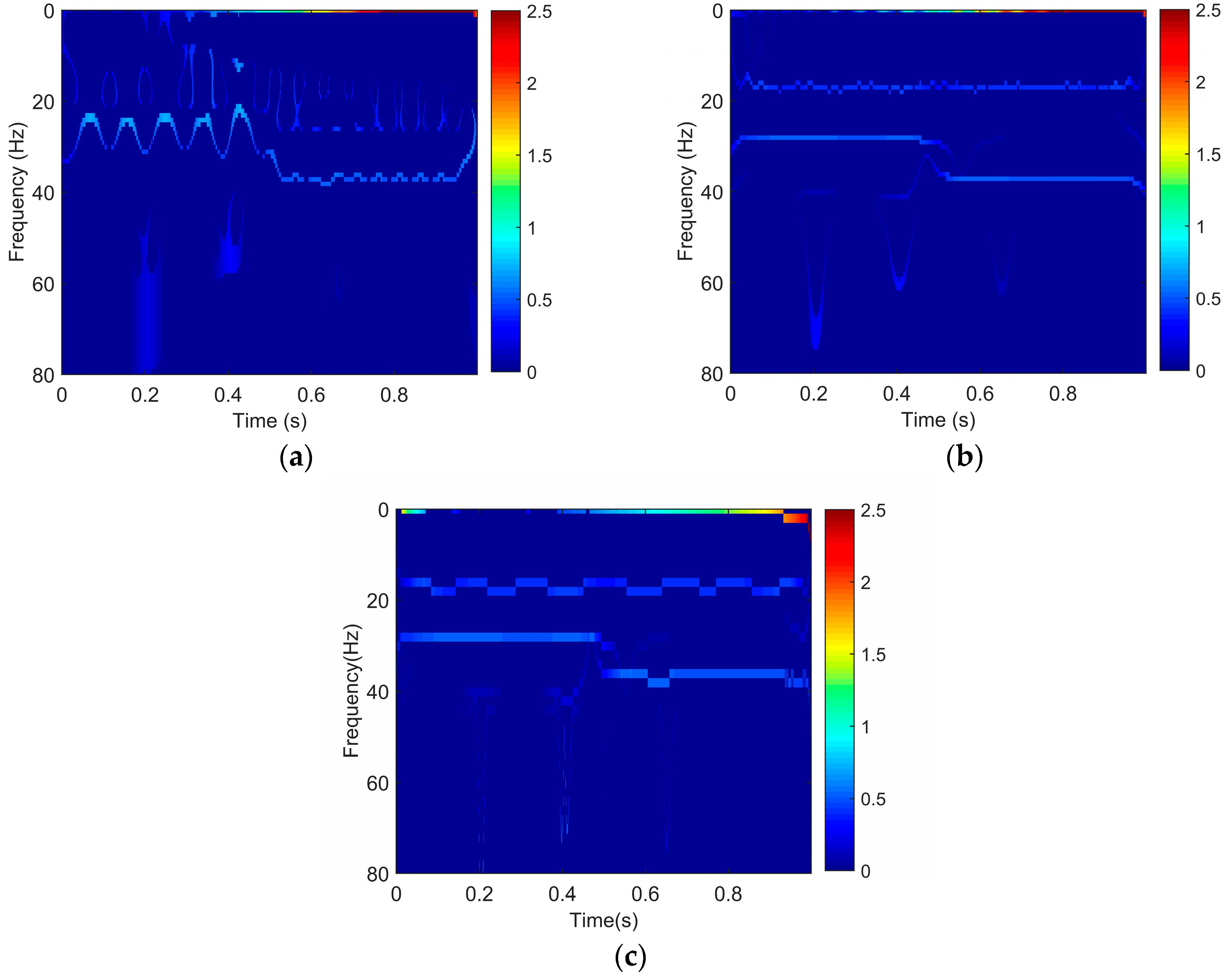
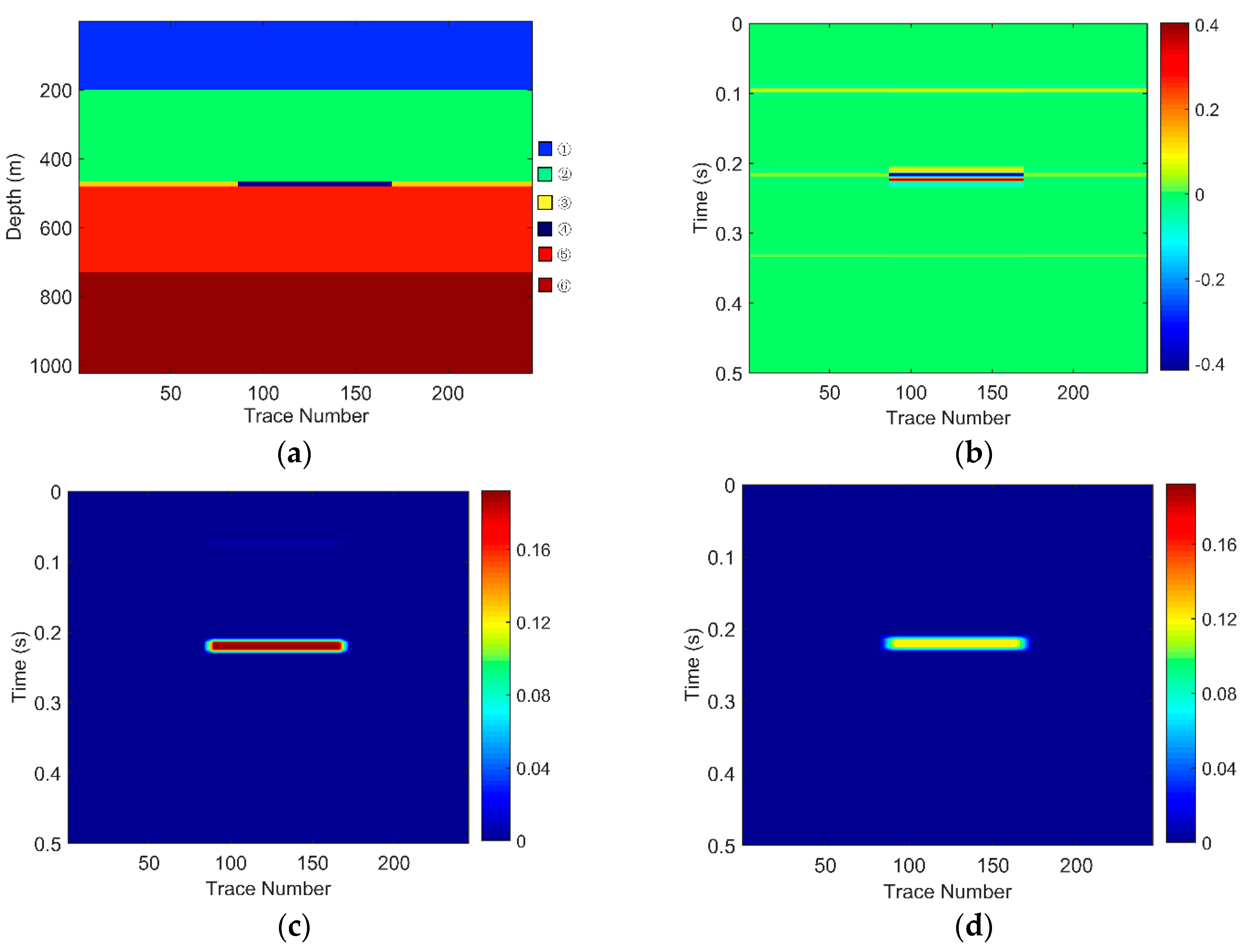
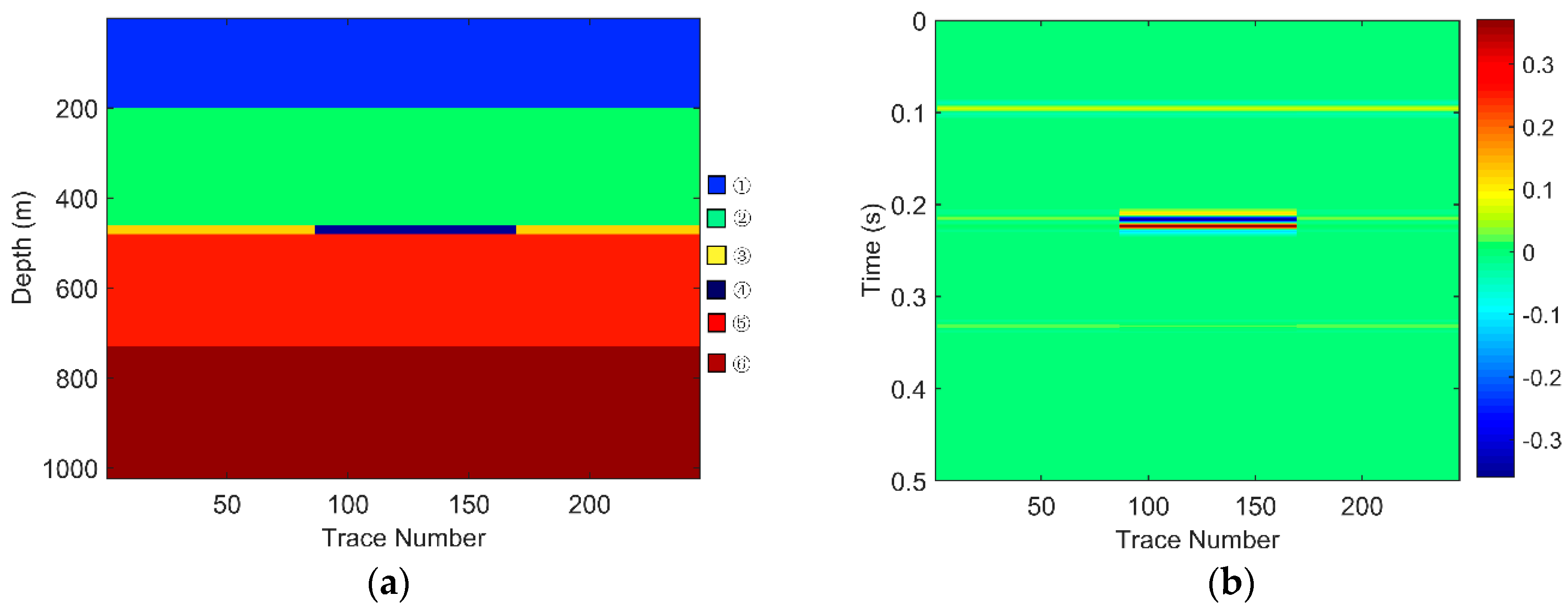
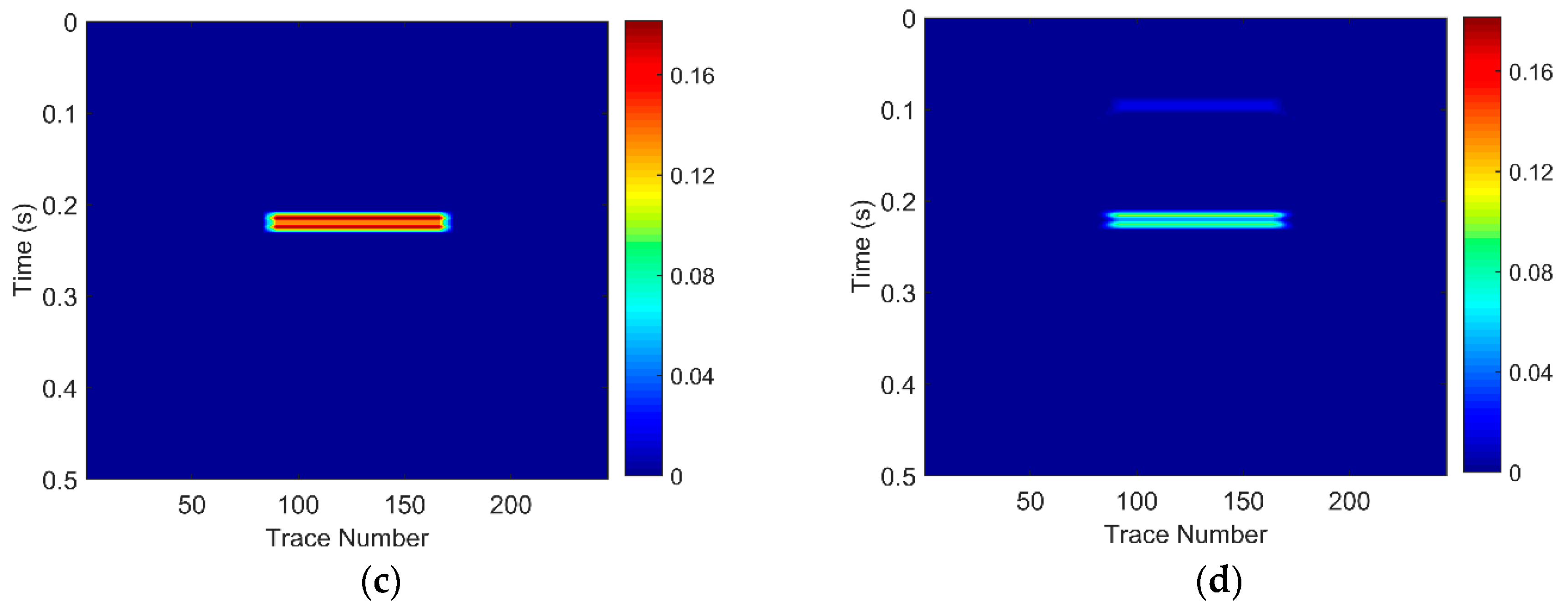
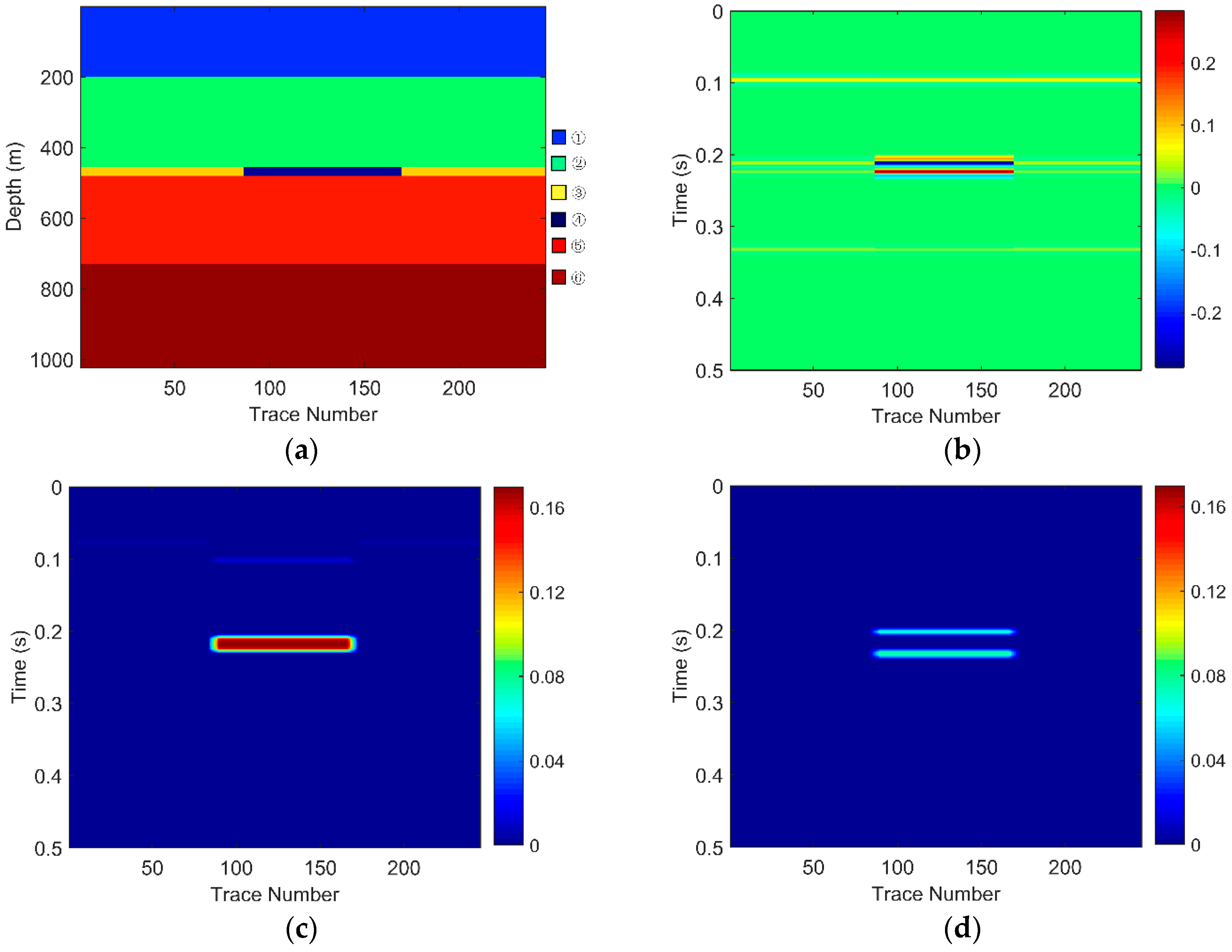
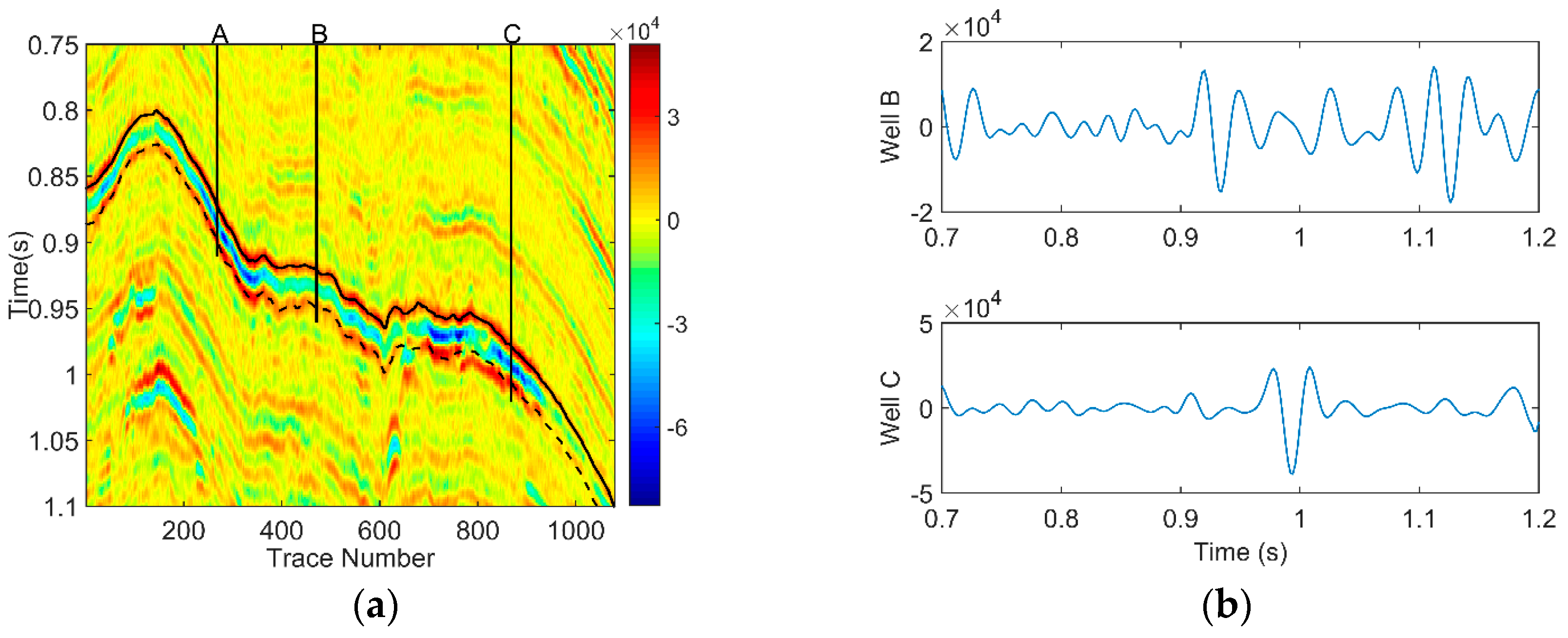
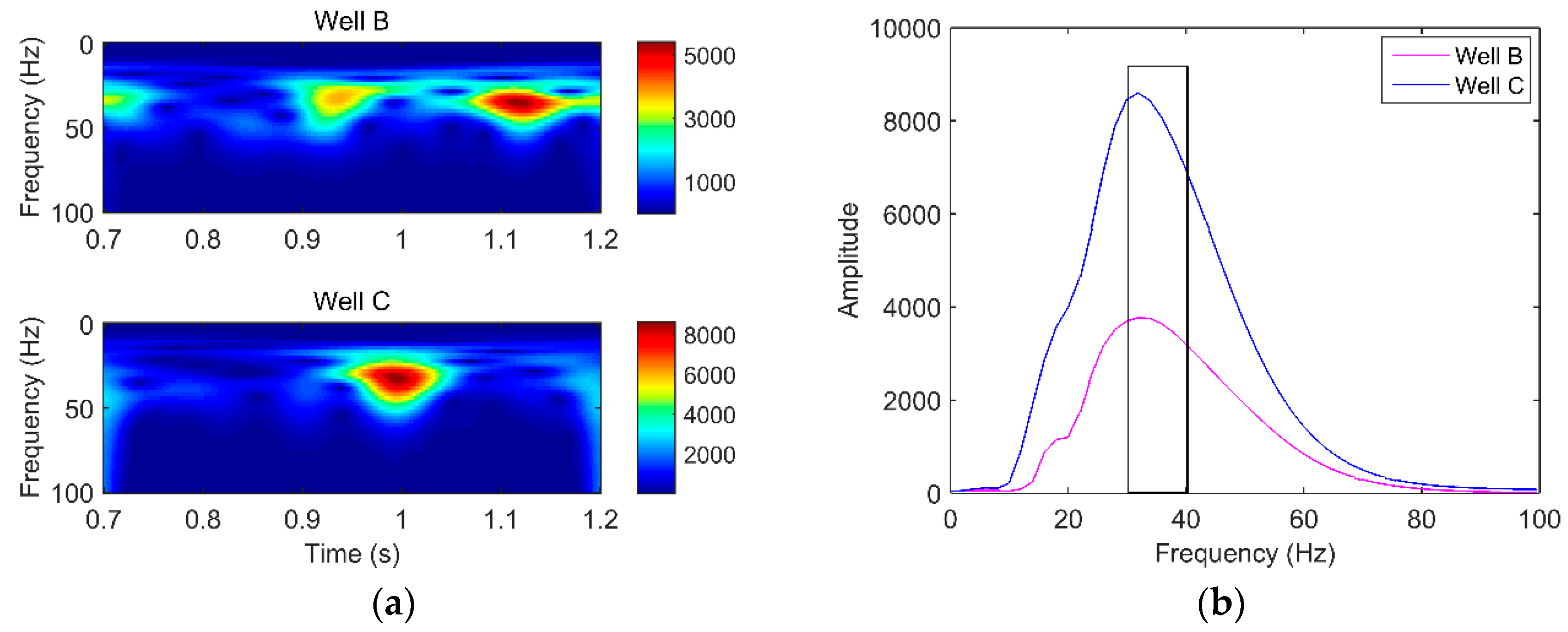
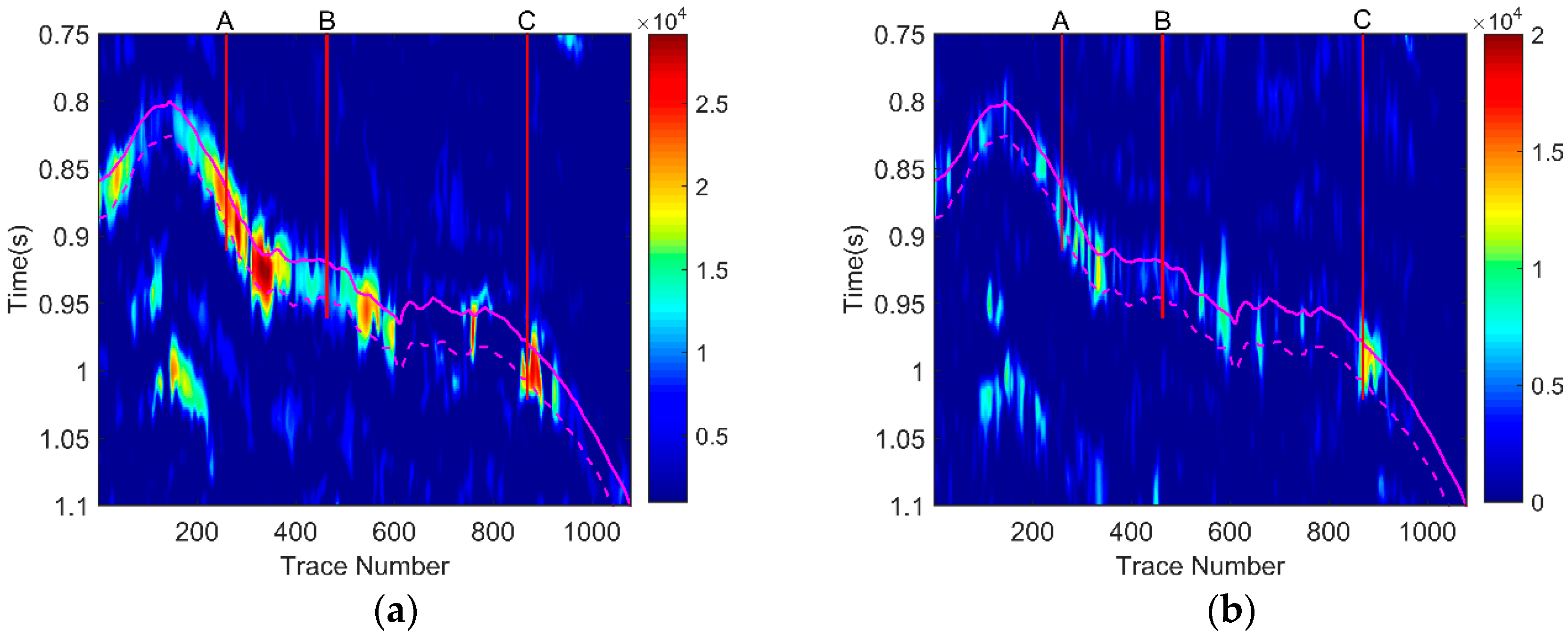
| Layer | Velocity (m·s−1) | Diffusion Coefficient (Hz) | Viscous Coefficient (m2·s−1) | Density (g·cm−3) | Q |
|---|---|---|---|---|---|
| ① | 4200 | 1.0 | 1.0 | 2.4 | 800 |
| ② | 4400 | 1.0 | 1.0 | 2.45 | 800 |
| ③ | 4500 | 1.0 | 1.0 | 2.5 | 800 |
| ④ | 4100 | 30.0 | 200 | 1.96 | 15 |
| ⑤ | 4600 | 1.0 | 1.0 | 2.5 | 800 |
| ⑥ | 4700 | 1.0 | 1.0 | 2.5 | 800 |
© 2017 by the authors. Licensee MDPI, Basel, Switzerland. This article is an open access article distributed under the terms and conditions of the Creative Commons Attribution (CC BY) license (http://creativecommons.org/licenses/by/4.0/).
Share and Cite
Chen, H.; Kang, J.; Chen, Y.; Xu, D.; Hu, Y. An Improved Time-Frequency Analysis Method for Hydrocarbon Detection Based on EWT and SET. Energies 2017, 10, 1090. https://doi.org/10.3390/en10081090
Chen H, Kang J, Chen Y, Xu D, Hu Y. An Improved Time-Frequency Analysis Method for Hydrocarbon Detection Based on EWT and SET. Energies. 2017; 10(8):1090. https://doi.org/10.3390/en10081090
Chicago/Turabian StyleChen, Hui, Jiaxing Kang, Yuanchun Chen, Dan Xu, and Ying Hu. 2017. "An Improved Time-Frequency Analysis Method for Hydrocarbon Detection Based on EWT and SET" Energies 10, no. 8: 1090. https://doi.org/10.3390/en10081090





